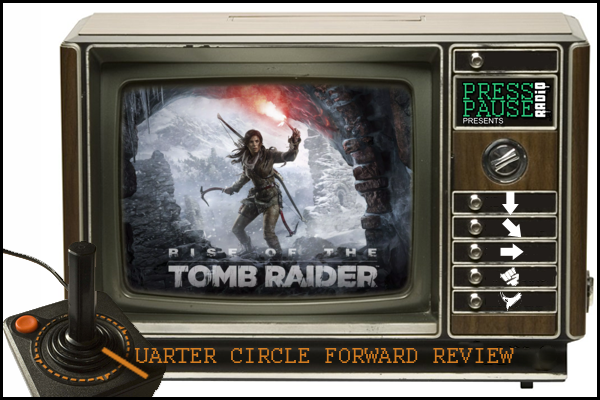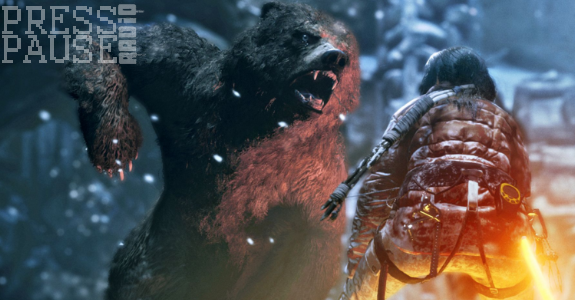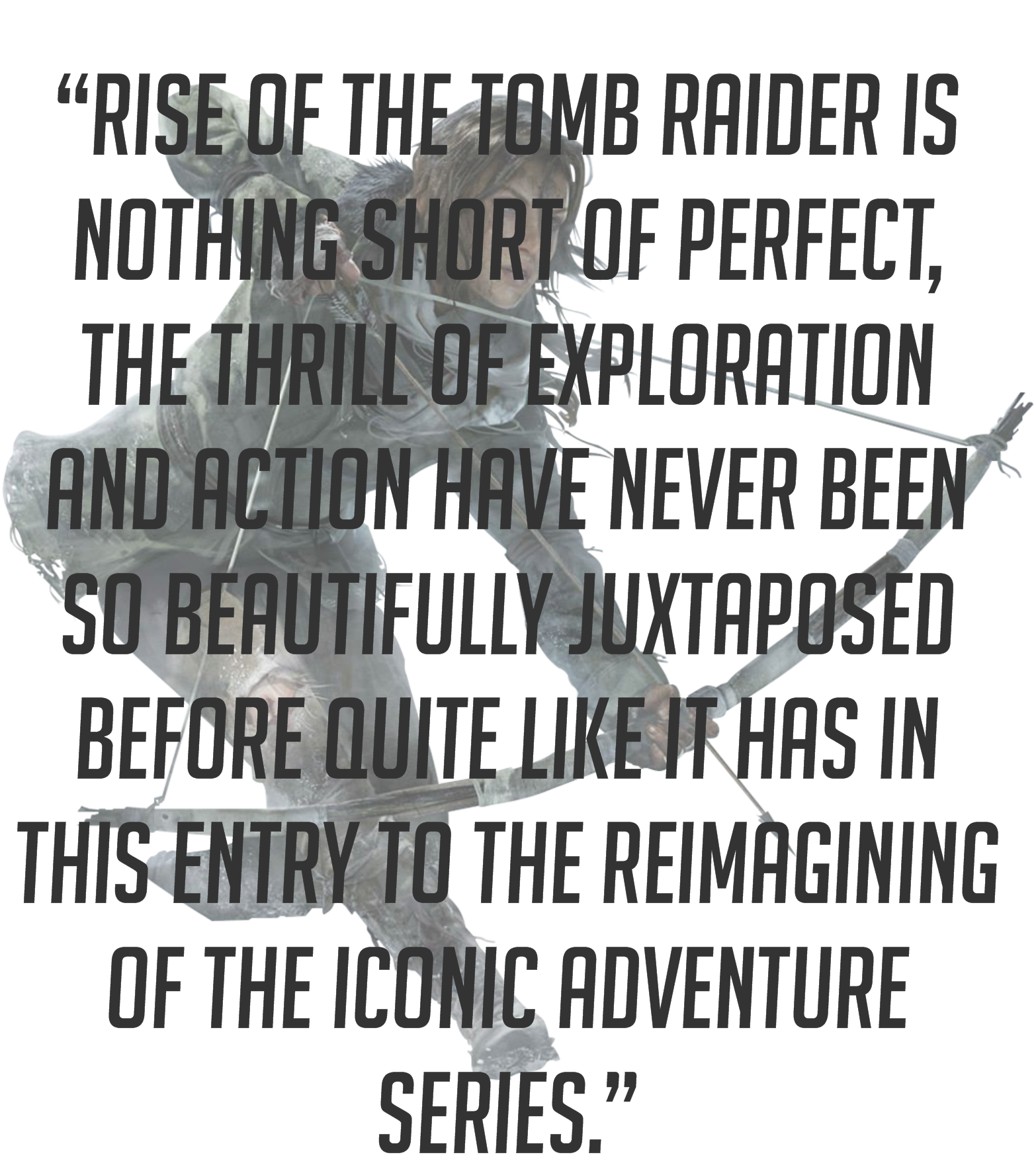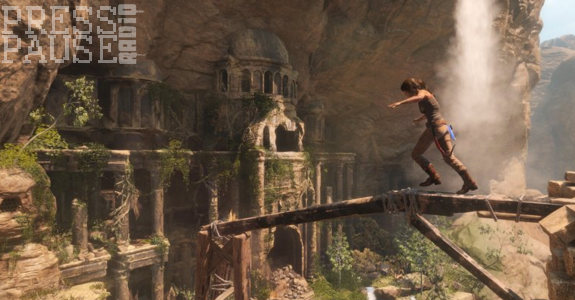QCF: Rise of The Tomb Raider

 ith a move that has controversially polarized whatever prospects it may have held with its respective audience since the initial announcement of the title, Phil Spencer declared that the sequel to Crystal Dynamics’s reboot of the iconic treasure-chasing heroine would be an Xbox exclusive for both console iterations of the 360, and the One.
ith a move that has controversially polarized whatever prospects it may have held with its respective audience since the initial announcement of the title, Phil Spencer declared that the sequel to Crystal Dynamics’s reboot of the iconic treasure-chasing heroine would be an Xbox exclusive for both console iterations of the 360, and the One.
Granted, it’s a limited claim on the property as the exclusivity is timed until late 2016, but it was one that Microsoft banked on giving them an advantage over the PlayStation that they didn’t have before; and some external circumstances not withstanding—they were right.
Rise of The Tomb Raider exemplifies every quality that defines what a good sequel should aspire to be, and it definitely exceeds every expectation its predecessor had set before it.
One of the most common points of references that often used to describe the dynamics of the new generation Tomb Raider is how similar it is to Sony’s flagship series Uncharted, and while the some of the comparisons are justly made, there’s one particular factor that Rise of The Tomb Raider captures so well, setting it apart from its contemporary.
Exploration—the open-world and locales of Siberia are not only a sight to behold, but are intuitively designed around all of Lara’s abilities and tools, in a fashion that will truly inspire players to get the most out of their raiding.

The thrill of scaling mountainsides and caverns in hopes of reaching that trinket really does offer a sense of reward within the journey itself than it does the destination. I know I’ve gone on about the importance of an open-world’s ability to harmonize with the action mechanics of gameplay and the means of traversal that it lends to, but design and execution of this concept is so well done.
The sense of discovery is so much more satisfying in an environment that’s organic to move around thanks to an articulate subtlety in its conveyance, and yet still enjoyably challenging to navigate within the same breadth.
I’d be hard-pressed not to mention another gameplay element that largely contributed to the fun of ‘raiding in ROTR, and that’s the experience and growth system for Lara. The mechanic was novel in the previous iteration sure, but this time around, the array of choices and options of pace it offers are much more engrossing to the gameplay.
Whether you’re killing enemies or wildlife, or unearthing collectables and locations, a majority of your actions and progress in the Siberian wilderness will yield you experience points that can be used to upgrade various areas of expertise for Lara to master, and plotting which perk will benefit your play style best only adds to the engagement of the venture.
 Each perk is different in how it upgrades Lara, and is capable of affecting multiple factors of the game, like the Hunting classification for example, provides an advancement that grants Croft multiple arrows for additional targeting on enemies within a single shot; a step-up that’s arguable more useful in combat than it is in hunting, or not.
Each perk is different in how it upgrades Lara, and is capable of affecting multiple factors of the game, like the Hunting classification for example, provides an advancement that grants Croft multiple arrows for additional targeting on enemies within a single shot; a step-up that’s arguable more useful in combat than it is in hunting, or not.
The skill tree is complex in all of the right ways, offering user-friendly avenues for advancement that’re also capable of facilitating additional benefits that aren’t immediately self-evident, and don’t necessarily need to be, considering how responsive the level design is to what Lara can do.
The refinement of towards the formula doesn’t stop there, the core elements like combat and crafting have also seen enhancements that truly redefine what they once were for the better. The targeting in shooting has a much smoother aliasing, which especially noticeable when using the bow, and melee is much more effective, making close-combat encounters much less of a pain than the system in the 2013 original. The only criticism here the actual quantity of resources, while there were issues with how frequent certain materials appeared over others, ROTR counters with it with the exact opposite, making nearly resource so abundant that it doesn’t add as much impedance to collect them.
Narratively speaking, the new direction with Croft’s character in this iteration of Tomb Raider was both intriguing, and refreshing, but the inconsistent pacing of her personal conflicts and how it developed her clashed with the immediate gameplay, and caused a haze of ludonarrative dissonance that was capable of unraveling even the most generous suspensions of disbelief. Fortunately, the sequel isn’t as capricious, allowing the other cast of characters who aren’t Lara, to expand beyond the surface of the roles they play within the plot.
Though the writing and direction is improved, the story still suffers from one particular drawback in Lara’s character—her motivation throughout the entire ordeal.
In the face of near impossible odds, and certain death, her main drive is to resume a treasure hunt that was one her father’s most ambitious discovery, and to prove that it exists, and recover the credibility of his name and reputation to the world. There are several points within the campaign to where she’s seemingly obtained what she’s sought after in this endeavor, pressing her hard to justify her unwavering determination to see the hunt for the lost city and it’s treasure through.
While it does incorporate the growth of character that Lara’s seen, along with a whole new side of vulnerability that we have yet to see in situation that she’s WILLINGLY put herself in this time, the resulting exposition to this narrative ends up hurting the complexity and intrigue of Lara. She just has to get this treasure you guys, for her father’s sake, for her sake, because reasons; it ends up coming off to be really one-dimensional at times.
One of the big changes that’s introduced in this sequel the expedition mode, which replaced the less than stellar multiplayer mode from the original. Expedition is an old-school score attack approach on the game, sequencing chapters of the campaign into a contest of skill. It’s the base the game but filtered into frantic arcade-like format where collectable items float in the air like a traditional side-scroller, along with completing meta challenges that affect the overall score after the stage is completed.

The other big component are digital cards that can be used as modifiers that offer a variety of conditions that work to either be an advantage, or disadvantage to the stage run they’re equipped for.
The execution doesn’t shy away at all from what it is, an empty-calorie binge that can indulge upon however they would like to. Something as simple as structuring the familiar open-world map into concentrated levels that emanate thrill of traditional video game challenge, that not only work towards building your intimacy even more with the game from a different angle, but they’re just plain dumb fun to play with.
Rise of The Tomb Raider is nothing short of perfect, the thrill of exploration and action have never been so beautifully juxtaposed before quite like it has in this entry to the reimagining of the iconic adventure series.
It’s a shame that the both game is held back by the limitations of its release this holiday, because it truly is must-play experience this holiday, and it belongs in the hands of every Xbox One owner out there now.

 Lara Croft,
Lara Croft,  Rise of The Tomb Raider,
Rise of The Tomb Raider,  Tomb Raider,
Tomb Raider,  Xbox 360,
Xbox 360,  Xbox One,
Xbox One,  timed exclusive,
timed exclusive,  uncharted | in
uncharted | in  QCF Reviews
QCF Reviews 









